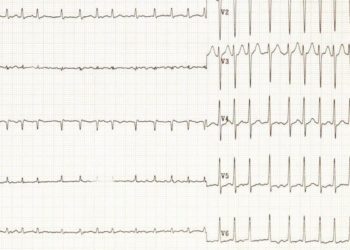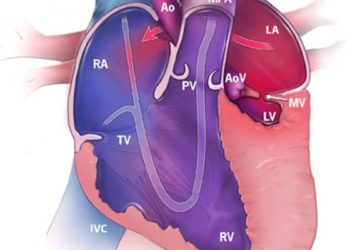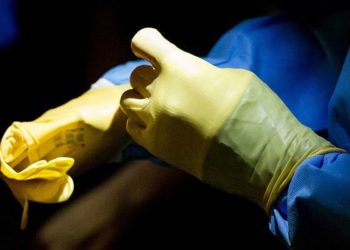#VisualAbstract: Continuous electrocardiogram monitoring following discharge detects atrial fibrillation in postoperative cardiac patients
1. Rates of detected atrial fibrillation (A fib) were significantly higher in postoperative cardiac surgery patients who wore a patch-based heart monitor for 30 days following randomization compared to those who underwent usual care.
2. A significant amount of time spent in A fib (6 hours cumulative, 24 hours cumulative) was detected amongst several patients undergoing continuous monitoring during the study period, but none of the patients undergoing usual care.
Evidence Rating Level: 1 (Excellent)
Study Rundown: Cardiac surgical patients are known to be at risk for developing episodes of postoperative atrial fibrillation (A fib), the majority of which are thought to occur in the days following surgery. The incidence of cardiac arrhythmias following discharge from cardiac surgery is poorly understood. This risk of developing undetected A fib is particularly salient for patients at high risk of stroke; the present randomized controlled trial sought to evaluate the utility of continuous electrocardiogram (ECG) monitoring for 30 days in this population. 336 adult patients undergoing cardiac surgery with no history of A fib or atrial flutter (A flutter) who developed one of these two arrhythmias during hospitalization and who were considered at high risk of stroke (see In-Depth) were included. The intervention group (163 patients, 48.5%) wore an adhesive patch ECG monitor for 30 days while the control group (173 patients, 51.5%) did not. Usual care included any ECG or Holter monitor testing which was clinically indicated. The primary outcome was cumulative A fib/A flutter duration of at least 6 minutes; this occurred in 19.6% of continuous monitoring patients versus 1.7% of controls. Cumulative A fib/A flutter lasting more than 6 hours was detected in 8.6% of the continuous monitoring patients, and none of the controls. The difference in rates of oral anticoagulant prescription within 45 days of randomization was not significant between the two groups. This investigation of continuous cardiac monitoring for 30 days following cardiac surgery amongst high stroke-risk patients demonstrated that nearly one in five patients experienced episodes of A fib/A flutter which would have otherwise gone undetected. These arrhythmias are known to be thrombogenic and often merit the initiation of oral anticoagulant therapy to prevent stroke or other thrombotic events. Strengths of this study include its novelty: the majority of studies of postoperative arrhythmias focus on the short timeline prior to discharge while Ha et al identified risks that extend for weeks and months postoperatively. The trial design was well-planned to control for bias, and the findings reported here are worth consideration in the management of high stroke-risk patients and the prescription of oral anticoagulants. In addition, thorough analyses (subgroup, as randomized) were performed to demonstrate the strength of findings. Some limitations include the relatively low sample size, owing in part to the COVID-19 pandemic which halted patient recruitment at 85% of the intended number. The eligibility criteria was fairly stringent, which reduces the external validity of this trial. Additionally, the limitations of continued ECG monitoring must be accounted for: this technology may be costly, can produce false positives and is associated with some adverse events which may reduce patient compliance.
Click to read the study in JAMA Network Open
Relevant Reading: Short- and long-term mortality associated with new-onset atrial fibrillation after coronary artery bypass grafting: A systematic review and meta-analysis
In-Depth [randomized controlled trial]: This trial took place at 8 cardiac surgical centres in Canada. High risk of stroke was evaluated using the CHA2DS2-VASc criteria with a score of 4 or higher, or with a score of at least 2 with an additional risk factor for stroke. Patients were excluded if they were already taking oral anticoagulants. Block randomization was performed by a computer-generated algorithm which stratified patients by study site and type of surgery. The projected sample size assuming a 2% attrition rate and an 80% power was 396, although enrollment fell short of this number. Intention-to-treat analysis was employed, although the study had good retention rates with 91.4% of patients attending all follow-up visits. There were no significant differences in baseline characteristics between the intervention and control groups. The absolute difference in rates of primary outcome between the two groups was 17.9% (19.6% versus 1.7%), with a 95% confidence interval (95CI) of 11.5-24.3% (p<0.001). The number needed to screen for this intervention was found to be 6 patients. The rates of arrhythmia incidence declined on a week-by-week basis, with 73.3% of A fib/A flutter episodes detected within the first week of the trial, 20.0% during the second week and 6.7% during the third. The absolute difference in rates of cumulative A fib/A flutter greater than 6 hours was 8.6% (8.6% versus 0%), 95CI 4.3-12.9% (p<0.001). 7 patients in the monitoring group and 4 in the control group were prescribed an oral anticoagulant within 45 days of randomization (absolute difference 2.0%, 95CI -1.9-5.8%). A subgroup analysis was planned a priori to investigate whether type of surgery was an effect modifier, and did not yield significant differences between the groups.
Image: PD
©2021 2 Minute Medicine, Inc. All rights reserved. No works may be reproduced without expressed written consent from 2 Minute Medicine, Inc. Inquire about licensing here. No article should be construed as medical advice and is not intended as such by the authors or by 2 Minute Medicine, Inc.








